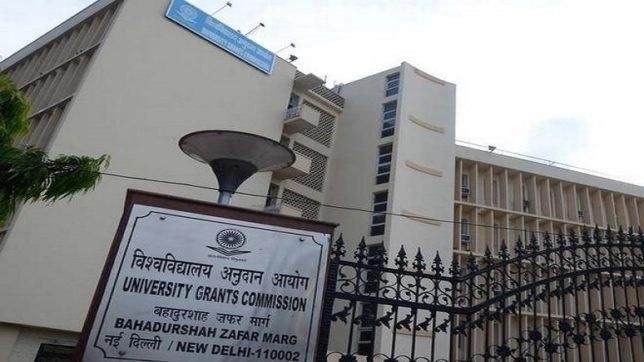Dismantling the UGC: A Design to Put Higher Education under the Absolute Command of Capital and Hindutva

In the month of June, most of the institutions of Higher learning in the country are busy preparing for the new academic session. While the teachers are busy finalising the results and the admission process, a fresh batch of students is trying to get admission in the institutions of their choice. It is at this juncture that the Ministry of Human Resource and Development (MHRD) came with an announcement regarding their plan to replace UGC with a new body of their vision. This new institution will be called Higher Education Commission of India. The MHRD also released a draft of the Act, which will be called “Higher Education Commission of India Act, 2018 (Repeal of University Grants Commission Act, 1956) according to the subsection 1 of Section 1 of the draft. This proposal is yet another move to accelerate the process of commodification of the higher education. While on one hand, it is designed to serve the interests of the private players in higher education; on the other hand, it seeks to bring the institutions of higher learning under complete centralized command -- to serve the capital, and also the ideological requirements of the current regime. In essence, it is a design of command at the service of finance capital and Hindutva. We will see how this design will operationalize based on the draft document.
The composition of the commission
According to subsection 3 of section 3 of the draft Act, “The Commission shall consist of a Chairperson, Vice Chairperson and twelve other Members to be appointed by the Central Government. The Secretary of the Commission will act as the Member-Secretary. Selection of Chairperson and vice chairperson will be done by Government from the panel submitted by the Search-Cum-Selection Committee (ScSc), consisting of Cabinet Secretary (Chairperson), Secretary Higher Education, and three other eminent academicians to be co-opted as members. Out of twelve members three will represent Central Government namely: Secretary of Higher Education, Secretary of Ministry of Skill Development and Entrepreneurship and Secretary Department of Science and Technology, two Chairpersons of other Regulatory Bodies of Education, namely Chairperson of All India Council for Technical Education and Chairperson of National Council for Teacher Education; two Chairpersons of the Executive Council/Governing Body of accreditation bodies; two serving vice chancellors of universities, two serving professors of universities and one will be from Industry.”
As is clear from the composition of the commission, the control-command structure is inbuilt in the very structure and the ruling party will have an absolute control over its composition. What departure does it bring to the university governance in the country? In spite of the fact that UGC too wasn’t immune to the ruling class’ machinations, its structure and its subservience to the parliament of India and hence to the bourgeois, democracy and its contradictions provided a far greater space to the forces committed to challenging the ruling class’ offensives. The proposed commission is inbuilt to diminish all such possibilities. It diminishes the role of students’, teachers' and karmachari movement to act as a pressure group. In fact, this is something which is the dream of the finance capital- the dream of dumping every compulsion of bourgeois democracy that acts as a hindrance in the path of profit maximization. What is perhaps most insightful is the fact that this has been a constant part of the neoliberal agenda in the last two decades, starting from Birla-Ambani report to Yashpal committee report to the Knowledge Commission. While the Congress made half-hearted efforts in this direction, RSS-BJP is going full steam in order to justify the shift of the big bourgeoisie’s support in its favour. This aspect is most central if we are to make sense of the current move.
Pushed in a hurried manner
This is a desperate effort of the BJP government to replace the existing structure of higher education to deregulate it. The way this draft Act has been announced and feedback have been asked within 10 days, shows the intention of the Government. It is unable to explain the basis on which its need was felt. There is very less time for teachers, academicians and students to react and give feedback on this draft. It looks like everything has been preplanned by the BJP government in view of 2019 election. They are just following the rituals by asking for feedback. Basically, it is just an eyewash to befool public.
Unjustified proposal
Neither the central government nor the MHRD is able to explain the need for the introduction of such Act that will replace a democratic governing body like UGC which is currently serving twin purpose of allocating grants and monitoring the minimum standards for education institution of higher learning. Basically, the most stressed point about HECI, 2018, is that it will ensure the minimum standards to be followed by the education institutions while UGC was a funding agency only. This is far from the truth. Even the UGC has been given the responsibility of promoting and coordinating university education, determining and maintaining standards of teaching, examination and research in universities and framing regulations on minimum standards of education. It publishes the list of institutions which are not fulfilling these standards. It can be given more power to take stringent actions against these institutions.
Not a new innovation of BJP Government
This is not a new effort of this government to dismantle UGC, even earlier, the UPA government had targeted UGC and other governing bodies of higher education through various Bills. BJP is following the path of neoliberal dogma which was pushed by the Congress for 10 years -- only with even more aggression. All this started with the proposal of National Council for Higher Education and Research (NCHER) during UPA followed by various other bills, which were turned down due to popular resistance from education fraternity. The BJP government also proposed Higher Education Empowerment Regulation Agency (HEERA) which was aimed to replace UGC and AICTE. This effort of government met with all cornered criticism and now the government is back with another proposal. The AICTE resisted to this proposal at the Mussoorie meeting stating that its merger into a HEERA-like body was hardly justifiable then. Now they have left AICTE out of this and only UGC is targeted. This proposal came at a time when after the defeat of proposal of HEERA, the government, through parliamentary standing committee, was already in the process to assess the workings of UGC by inviting public feedback.
It excludes Institutions of National Importance
This draft Act reflects BJP government’s lack of proper vision about the higher education of India because the Act will not be applicable to the Institutions of National Importance. Sub-section 2 of section 1 reads, “This Act is applicable for all higher educational institutions established, under any Act of the Parliament excluding Institutions of National Importance so notified by the Government, Act of State Legislature and to all Institutions Deemed to be Universities so notified by the Government.” The institution of national importance includes some of India’s best-known institution which has an immense contribution. Why these institutions are left out of the ambient of the regulatory body for higher education is a question to which the current regime has no answer.
Distribution of Grant by Ministry
The proposed HECI will not be distributing grants to the educational institution but this role will be taken over by the Ministry of Human Resource Development and subsequently will lead to a more direct interference of the central government. The ministry of human resource development will be deciding the amount grant to a university and also the timing of its release. Presently, the government’s funding for public higher education is distributed through the UGC, an autonomous body under the HRD ministry. UGC has an academic background which enables it to distribute funds according to the need of the educational institutions. But the ministry doesn’t have such an academic background. This is contrary to one of the goals of the proposed commission of decreasing the government interference in education institutions. With the funds now being controlled directly by the Ministry, it will interfere much more directly into the workings of the institutions and this can be used to influence the working of education institutions. Any institution which will refuse to follow the ministry may be targeted and starved for funds. This is most likely going to be the case for the institutions which are known for their fearless analysis of government policies. At the present juncture, the universities in the opposition-ruled states and minority institutions of higher education are already facing difficulties and are alleging discrimination by the BJP-led NDA government at the Centre.
Over monitoring
Along with other functions of the proposed HECI as described in section 15 of proposed draft, a few specific functions have also been mentioned, including specifying learning outcomes, laying down standards of teaching/assessment/research, evaluating the yearly academic performance, promoting research, putting in place a robust accreditation system, providing for mentoring of institutions, etc. The whole approach is focused on the accreditation and yearly evaluation of higher education institutions that will create a system of over-regulation. Most of these functions are already being done through various schemes of the UGC or Governments. The National Assessment and Accreditation Council (NAAC) is an autonomous body of UGC, which does provide the assessment and accreditation of the HEIs in India. UGC has a Faculty Development Programme (FDP), which works on improving the teaching in higher educational institutions. The whole shift is towards learning outcomes approach without understanding the limitation of the process. This is an approach to facilitate further commercialization of education through a corporate approach to the education sector which focuses on homogeneous, one-size-fits-all administrative models and best practices which is against the process of allowing the institutions to evolve over time, based on their specific needs.
More stresses on performance
The proposed HECI is inspired by the market approach of BJP government where institutions are proposed to assess only on their so-called performance without taking care of geographical and social location of the institution. Section 15, sub-section 4, clause ‘e’ of the draft Act defines one of the functions of HECI as “Lay down norms and standards for performance-based incentivization to the faculty and the Higher Educational Institutions and the Universities”. Performance-based incentivization means more money to the institutions which are showing good performance and fewer incentives to the institutions with bad performance. This approach is against the concept of the real need of the institution and a market-driven approach. For example, an institution (college or university) serving in a remote area of Bihar with vacant posts of teachers is ought to show bad results in comparison to some other well-equipped institution. There is a need to give extra monetary input to this educational institution to improve its infrastructure and recruit faculty. But according to the above approach, this institution will receive less incentive and subsequently there will be further degradation in performance. This will not strengthen the educational institutions which really need help but will serve against to their needs. This was the cardinal and well-propagated approach of Rashtriya Uchchatar Shiksha Abhiyan (RUSA).
The draft Act also mandated for Graded Autonomy to Universities and Higher Educational Institutions which is already a matter of great debate in India. The MHRD’s decision of giving graded autonomy to 62 institutions is already adversely affecting students and has resulted in massive fee hikes.
Killing autonomy, while parroting autonomy
The structure and provisions proposed in the draft Act clearly suggest the total control of Government over HECI. The proposed law empowers central government to remove any or all members including the chairperson and vice chairperson for specified reasons. This is not the case with the existing structure of UGC. Presently, the UGC chairman, vice-chairman and any of its 10 members cannot be removed by the government. It ensures the autonomy and can resist any pressure from sitting government ensuring that academic standards in the institutions of higher education are governed by new fact-based research. This provision can be used for motivated reasons.
There are additional checkpoints on the functioning of HECI through advisory council which will be headed by the HRD minister. Section 24 of the act states “There shall be an Advisory Council chaired by the Union Minister for Human Resources Development, and with the Chairperson/Vice-Chairperson, members of the Commission, and Chairperson/Vice-Chairpersons of all State Councils for Higher Education as members.” There is no such council under the existing UGC Act. This means ministry directly will be giving directions to the HECI chairman appointed by him. Presently there is no provision for such council under the existing UGC Act.
There are limitations of the UGC and its working which should be improved and it should be made more democratic and transparent instead of just replacing with a body which will become a remote control in the hands of central Government. It can be given more powers to act against the defaulters and institutions which do not fulfil the minimum prescribed standards and parameters. UGC was set up on the recommendation of the University Education Commission in 1948 under the chairmanship of Dr S. Radhakrishnan to convert University Grant Committee into University Grant Commission. The very aim of the formation of the UGC and UGC Act was to develop and evolve a structure of quality education institutions without political intervention and worry of funding. The proposed Higher Education Commission of India Act, 2018 (Repeal of University Grants Commission Act, 1956) will not simply replace the UGC but reverse the process. This will bring more control of Government over higher education and will pave a way for further commercialization of higher education. If we really want to improve the quality and autonomy of higher education there is a need to strengthen the UGC with more budget at its disposal, more manpower and autonomy.
It is in the background of the points outlined above that we need to build a unified movement and force the government to annul this disastrous move. It is most likely that the government will be able to push these changes in the short time frame; however, we should prepare our forces to build massive opinion mobilization on the policy question and also intervene to build movements when these changes manifest in their concrete forms at the level of institutions. This twin approach is going to be central to fighting and reversing this offensive.
Get the latest reports & analysis with people's perspective on Protests, movements & deep analytical videos, discussions of the current affairs in your Telegram app. Subscribe to NewsClick's Telegram channel & get Real-Time updates on stories, as they get published on our website.























